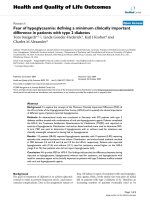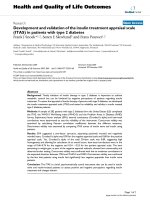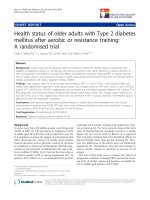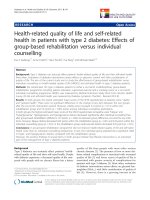children and adolescents with type 2 diabetes andor metabolic syndrome pathophysiology and treatment
Bạn đang xem bản rút gọn của tài liệu. Xem và tải ngay bản đầy đủ của tài liệu tại đây (856.61 KB, 36 trang )
Children and Adolescents with Type
2 Diabetes and/or
Metabolic Syndrome:
Pathophysiology and Treatment
International Diabetes Center
Components of the Metabolic Syndrome
Focus of treatment
in children
Hyperglycemia
Dyslipidemia
Hypertension
Insulin
Resistance
Abnormal
Thrombotic Risk
vascular behavior
Fat Mass
International Diabetes Center
Master DecisionPath for
Metabolic Syndrome
International Diabetes Center
Master DecisionPath for
Metabolic Syndrome
Fat Mass
International Diabetes Center
Role of Obesity In
Metabolic Syndrome
•
•
TNF-α
Abdominal adipose tissue is more
metabolically active than
subcutaneous fat
•
FFA
Central obesity is critical factor
– Waist to hip ratio >1
Increased release of FFA, TNFα leading to insulin resistance
Others (Resistin)
International Diabetes Center
Obesity and Complications
97% of all obese adolescents
had 4 or more of the following risk factors:
•
Elevated TG, Total cholesterol
Decreased HDL cholesterol
Elevated SBP/DBP or both
Diminished maximal oxygen consumption
Strong family history in immediate family (CVD,
MI,
angina, or HTN)
New England Journal of Medicine. Vol.346, 2002.
International Diabetes Center
Weight Categories for Persons Between 2 and 20
Years of Age
• Underweight = BMI-for-age <5th
percentile*
• Overweight = BMI-for-age >83rd percentile
• Obese =
BMI-for-age >93rd percentile
*Adjusted for Asia, based on US BMI Charts
International Diabetes Center
Significance of Problem:
Epidemic in the United States and around the world
Risk of Type 2
DM increases by
4% for every
pound of excess
body weight. In
2004 15.3% of 611 years of age
and 15.5% of 1219 years of age.
International Diabetes Center
Comparison of Asian and Caucasian
Children
Age
BMI
Caucasian
Asian
%
2 years
19.0
93
4 years
17.4
93
9 years
20.4
93
13 years
24.5
93
_________________________________
Example: the BMI declines
during preschool years and
increases with age, yet
remains at the 93rd percentile
BMI-for-age.
Center of Disease Control. www.cdc.gov
International Diabetes Center
Weight Maintenance or Weight Loss:
Age/Morbidity Related Recommendations*
2-7 Years of Age
BMI 83-93 Percentile
> 7 Years of Age
BMI >93 Percentile
No complications
Weight
Maintenance
Complications
Weight
Loss
*US Centers for Disease Control and Prevention
BMI 83-93 Percentile
No complications
Weight
Maintenance
BMI >93 Percentile
Complications
Weight Loss
International Diabetes Center
Principles of Weight Maintenance :
> 83rd Percentile BMI for Age
• Stabilize current weight
• Balance energy intake (calories)
with energy output (activity)
• Replace, Reduce and Restrict
foods and drinks to achieve goals
• Increase level of activity
appropriate to child or adolescent
International Diabetes Center
Weight Maintenance: a Balancing Act
Weight Loss
Energy
Intake
Weight Gain
Energy
Output
Behavior
International Diabetes Center
Medical Nutrition Strategies to Maintain
Current Weight: Replace, Reduce, Restrict
Replace: Simple carbohydrates
and high fat foods
Increase complex carbohydrates
(whole fruits, vegetables
and whole grain foods)
Reduce: Portion size
Decrease drink, snack and
meal sizes by at least 10%
R
Restrict: Caloric intake
e
Goal: 30% Fat, 50% Carbohydrate
and 20% Protein
International Diabetes Center
Principles of Weight Loss :
•
•
Stabilize current weight first
Slow weight loss (age dependent) –1
to 4 lbs (.5-2.0 kg) per month
• Decrease energy intake (calories)
and increase energy output (activity)
• Replace, Reduce and Restrict foods
and drinks to achieve goals
• Increase level of activity appropriate
to child or adolescent
International Diabetes Center
Weight Loss: a Balancing Act
Weight Loss
ergy
En
take
In
Weight Gain
ergy
En
put
Out
Behavior
International Diabetes Center
Weight Loss
#1 Goal = STOP the weight gain
# 2 Goal = Work on modest
weight loss
– Decrease calories 100-300 kcal/day for
weight loss
– Reduce reliance on carbohydrates and fats
International Diabetes Center
Medical Nutrition Strategies to Lose Weight:
Replace, Reduce, Restrict
Replace: Simple carbohydrates
and high fat foods
Increase complex carbohydrates
(whole fruits, vegetables
and whole grain foods)
Reduce: Portion size
Decrease drink, snack and
meal sizes by at least >10%
R
Restrict: Caloric intake
e
Goal: 30% Fat, 50% Carbohydrate
and 20% Protein
International Diabetes Center
Exercise Prescriptions
• 83rd-93rd percentile BMI
Recommend aerobic activities & weight-bearing
activities: brisk walking, field sports, hiking,
rollerblading, etc.
• 93rd-97th percentile BMI
Primarily non-weight-bearing: swimming, cycling,
circuit training, arm-specific aerobic chair
dancing, recline bike, interval walking
• >97th percentile BMI
Non-weight-bearing activities only: swimming,
recline bike, arm ergometer, seated (chair)
aerobics, seated or lying circuit training March 2002
Sothern, M. JADA.
International Diabetes Center
Master DecisionPath for
Metabolic Syndrome
Hyperglycemia
Type 1, Type 2 or MODY?
International Diabetes Center
Differentiating Between Type 1 and Type
2
Type 1
• Classic signs/symptoms
• Profound weight loss
over a short time period
• Ketones present
• DKA at presentation if
persistent untreated
hyperglycemia (25% of
the cases)
• Responds only to insulin
• Autoantibodies to islet
cells present
Type 2
• Classic signs and
symptoms may occur
• Often asymptomatic
• Weight loss only occurs if
significant and prolonged
hyperglycemia
• Ketones generally not
present
• Responds to changes in
diet, weight management
or pharmacologic agent
• Autoantibodies to islet
cells not present
International Diabetes Center
MODY: Maturity Onset Diabetes of
Youth
• Rare, autosomal
dominant inheritance
• Normal weight and BP
• < Age 25 and usually
non-ketotic at
presentation
• Family history of
diabetes without obesity
• Negative ICA, IAA and
GAD antibodies
• Responds to insulin and
sulfonylureas
International Diabetes Center
Risks Associated with the Development of
Type 2 Diabetes in Children and Adolescents
Environmental/Lifestyle Factors
1. Change in diet- high fat and
carbohydrate
2. Increase in portions and availability
of food products
3. Decrease in physical activity
4. Increase in sedentary activities
5. Unstructured meals & eating out
Genetic Factors
1. Thrifty gene
2. Homogeneous population
International Diabetes Center
Therapies for Type 2 Diabetes
• Medical Nutrition Therapy
(MNT)
– Activity/Exercise
• Pharmacologic Therapies
– Metformin
– Insulin
International Diabetes Center
% of
Normal Function
Glucose (mg/dL)
Metformin
Medical
Nutrition
350
300
250
200
150
100
50
Insulin
Post Meal Glucose
Fasting Glucose
(11.1 mmol/L)
(7.0 mmol/L)
250
200
150
100
50
0
Insulin Resistance
Insulin Level
At risk for Diabetes
-10
-5
Beta cell dysfunction
0
5
10
15
20
25
30
Years of Diabetes
Adapted from: UKPDS 33: Lancet 1998; 352, 837-853 DeFronzo RA. Diabetes. 37:667, 1988.
Saltiel J. Diabetes. 45:1661-1669, 1996. Robertson RP. Diabetes. 43:1085, 1994.
Tokuyama Y. Diabetes 44:1447, 1995. Polonsky KS. N Engl J Med 1996;334:777.
International Diabetes Center
©2000 International Diabetes Center. All rights reserved
Type 2 Master DecisionPath
for Children and Adolescents
Food Plan and Exercise
Metformin
Mixed Insulin
Physiologic Insulin
International Diabetes Center









